The Featured Creatures collection provides in-depth profiles of insects, nematodes, arachnids and other organisms relevant to Florida. These profiles are intended for the use of interested laypersons with some knowledge of biology as well as academic audiences.
Introduction
Anasaitis canosa, commonly known as the twin-flagged jumping spider, is one of over 6000 described species in the jumping spider family Salticidae (World Spider Catalog 2022). Anasaitis canosa is a relatively small spider (4-7 mm in length) that is commonly found throughout the southeastern United States and Mexico (Edwards 1999) (Figure 1).
This species is appropriately named for the bright white markings on its pedipalps (the small pair of appendages near the face of the spider) that resemble small white flags when waved around. These pedipalp “flags” make this species fairly easy to recognize when encountered in a variety of habitats including forest floor leaf litter and in or on buildings (Edwards and Marshall 2013).
This species is unusual among jumping spiders in that it is a specialist predator of ants (Edwards et al. 1974, Hill 2006, Jackson & Van Olphen 1991), but it also feeds on a variety of other invertebrates (Jackson & Van Olphen 1991, Schadegg and King 2021). Like all jumping spiders, Anasaitis canosa has venom that it injects into prey upon attack (Foelix 2011), but this species is harmless to humans and does not bite. It is considered beneficial in agroecosystems where it likely feeds on insect pests (see Young and Edwards 1990).
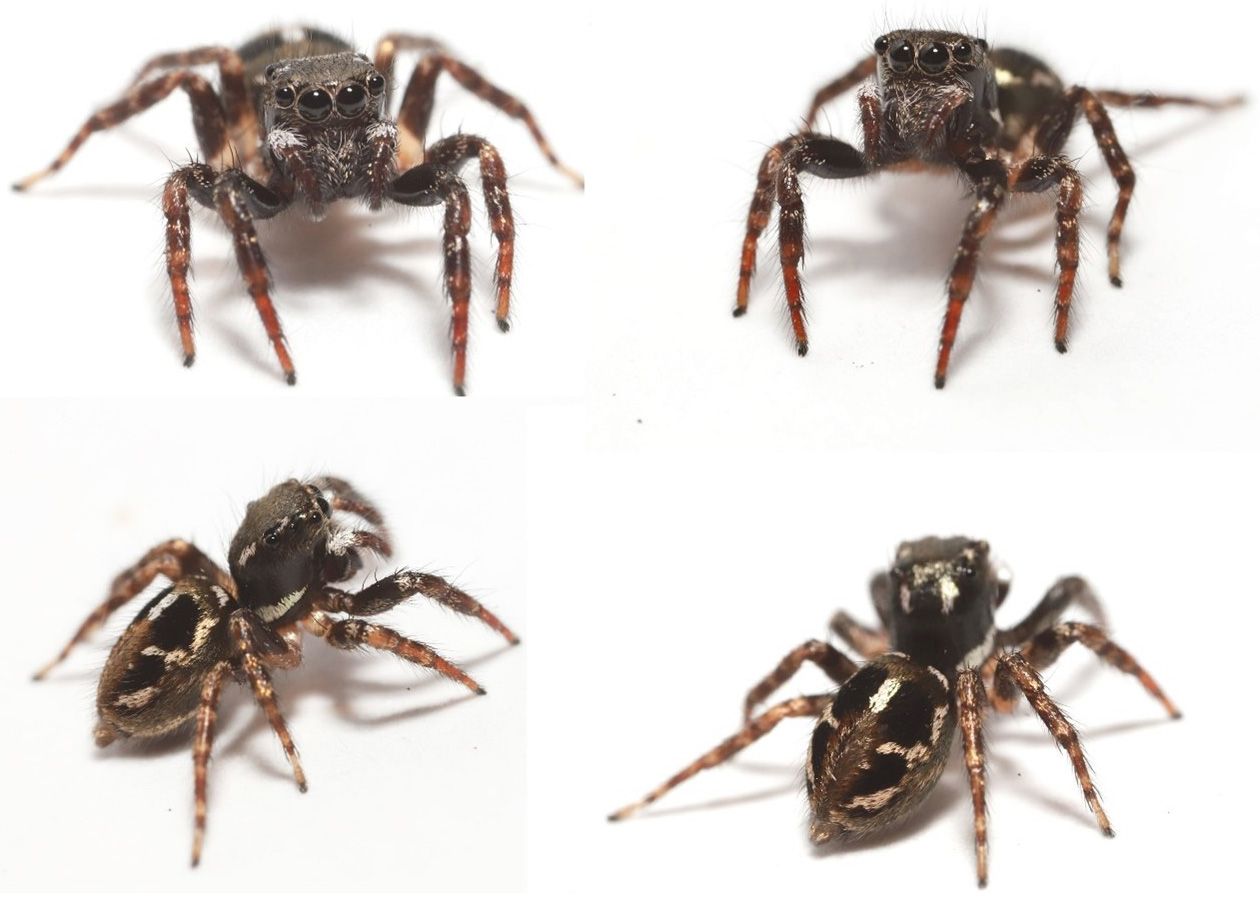
Credit: E. C. Powell, UF/IFAS
Synonymy
Attus canosus Walckenaer, 1837
Attus magus Walckenaer, 1837
Attus auratus Hentz, 1846
Menemerus cruciferus Keyserling, 1885
Prostheclina cambridgii Peckham & Peckham, 1888
Prostheclina aurata Banks 1893
Pellenes auratus Simon, 1901
Stoidis auratus Peckham & Peckham, 1909
Corythalia aurata Bryant, 1940
Stoidis canosa Chamberlin & Ivie, 1944
Stoidis aurita Prószyński, 1976
Corythalia canosa Richman, 1978
Anasaitis canosa Edwards, 1999
Distribution
Anasaitis canosa is found in the southeastern United States and in Mexico. In the United States, it is known from Alabama, Arkansas, Florida, Georgia, Louisiana, Mississippi, Oklahoma, South Carolina, and Texas (Richman et al. 2012). However, this range might extend further north than previously recognized, with specimens found recently in Indiana (Milne et al. 2019) and records on iNaturalist suggesting that they also range into North Carolina, Tennessee, and Virginia (iNaturalist 2022). In Mexico, this species is known from the state of Tamaulipas (Richman 2011).
Identification
Members of the jumping spider family Salticidae can be most easily distinguished from other types of spiders by their large, forward-facing anterior median eyes and their stout body shape (Foelix 2011) (Figure 1).
Anasaitis canosa adults have a dark brown or black body, often with a golden sheen, and four white markings on the cephalothorax (or head) (Walckenaer 1837) (Figure 1,2,3,5,6). Iridescent white, or nearly white, markings in the center and along the margins of the abdomen outline four central dark abdominal spots.
In the field, Anasaitis canosa can be most easily recognized by the conspicuous movement of the white “flags” on the pedipalps (Edwards and Marshall 2013). Like other jumping spiders, Anasaitis canosa is active during the day and is relatively conspicuous as it walks and jumps through the leaf litter. They do not build webs for prey capture, but use silk for draglines, resting retreats, and constructing egg sacs (Foelix 2011).
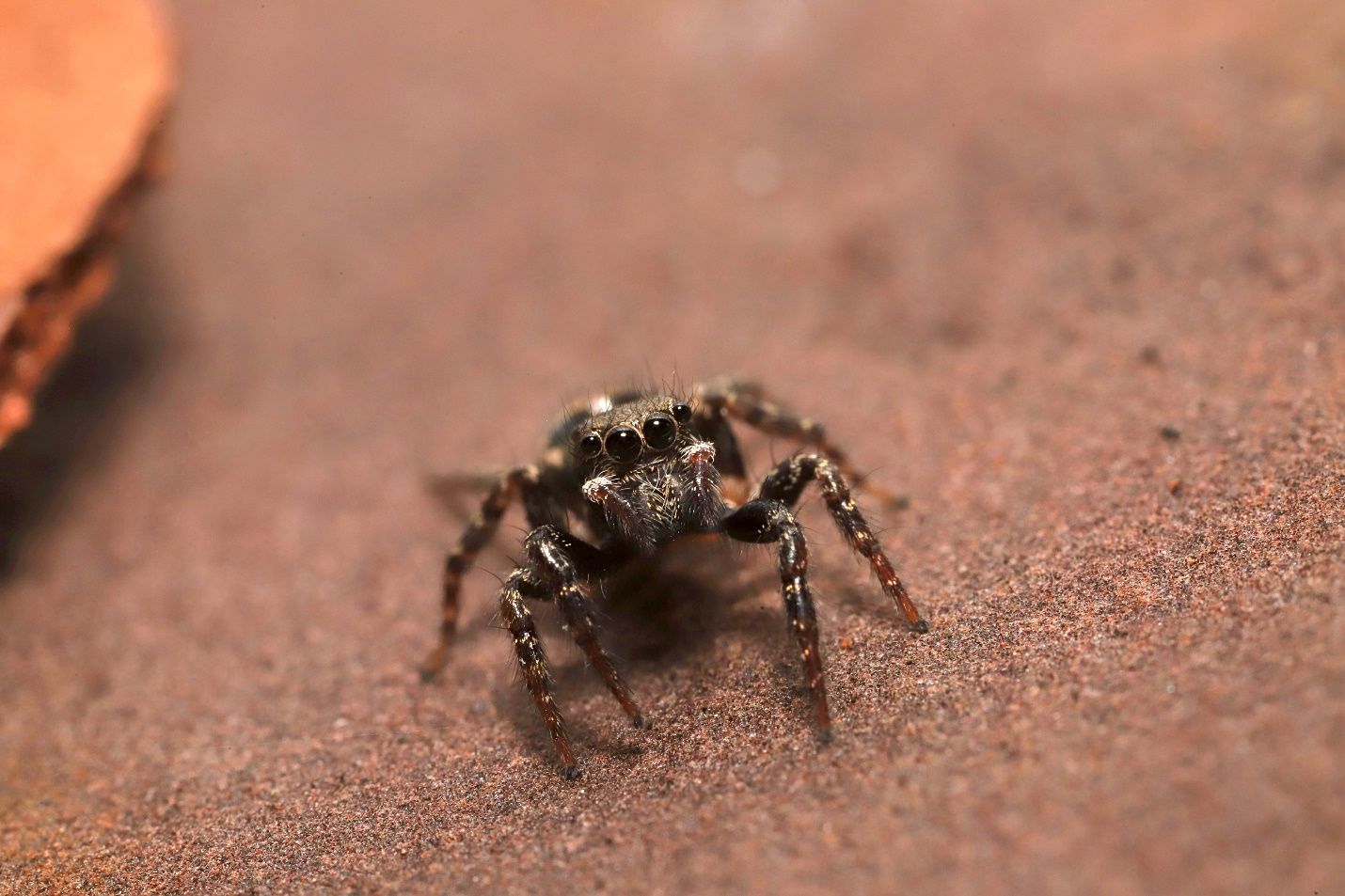
Credit: E. C. Powell, UF/IFAS
Adult males, females, and juveniles are similar in shape and coloration, but the adult males are slightly smaller and less robust than the adult females (Figure 3) (Edwards 1999). Young juveniles have paler legs and pedipalps but the pedipalp “flags” made up of bright white scales are still visible (Figure 4).
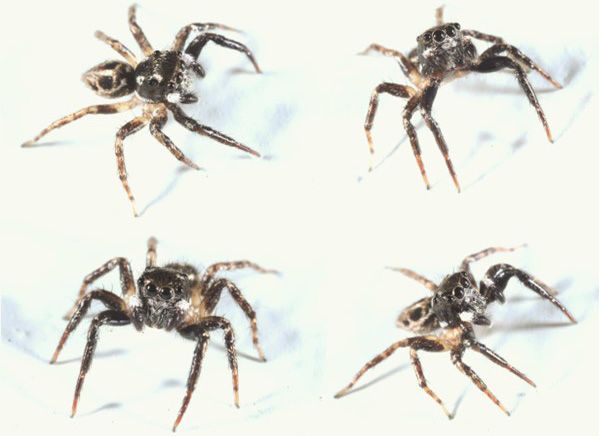
Credit: E. C. Powell, UF/IFAS
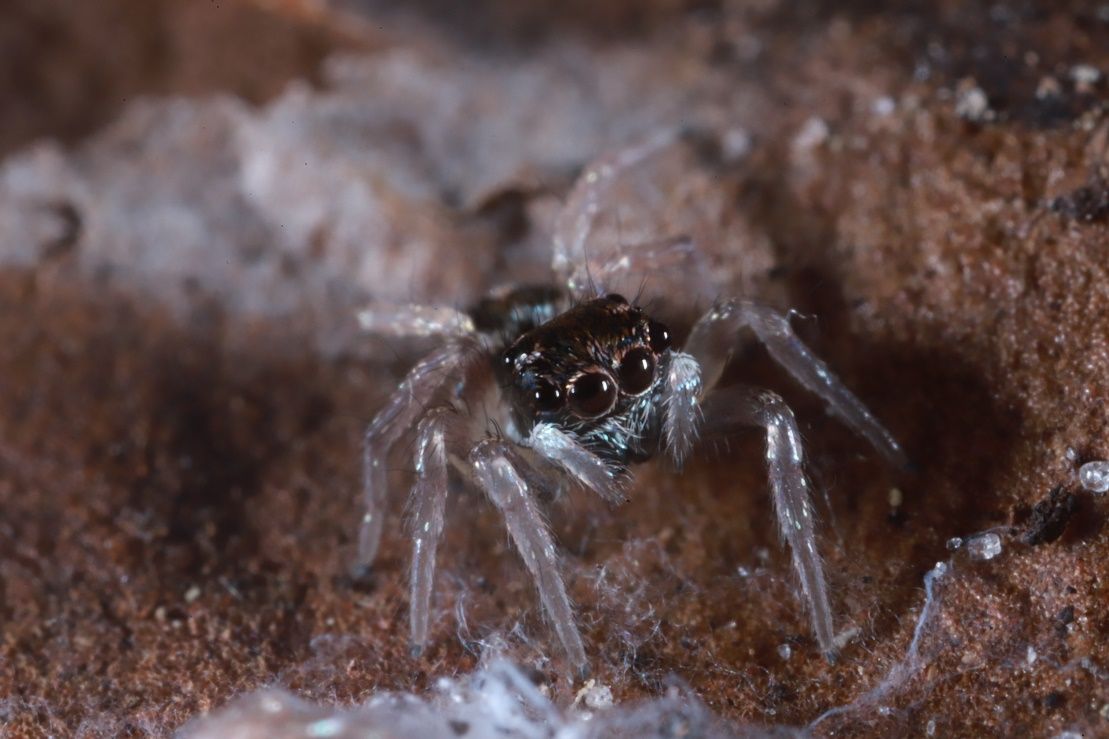
Credit: E. C. Powell, UF/IFAS
Locomotion and Courtship Behavior
Anasaitis canosa can often be seen moving throughout the leaf litter in shaded forest habitats (Hill 2006). Both juvenile and adult Anasaitis canosa commonly build silk nests in leaf litter on the ground of their natural habitats (Hill 2006). Individuals may also build their silk nests under pine bark. Anasaitis canosa is also common in urban environments such as in and around houses, on pavilions, picnic benches, and other human structures (Figure 5).
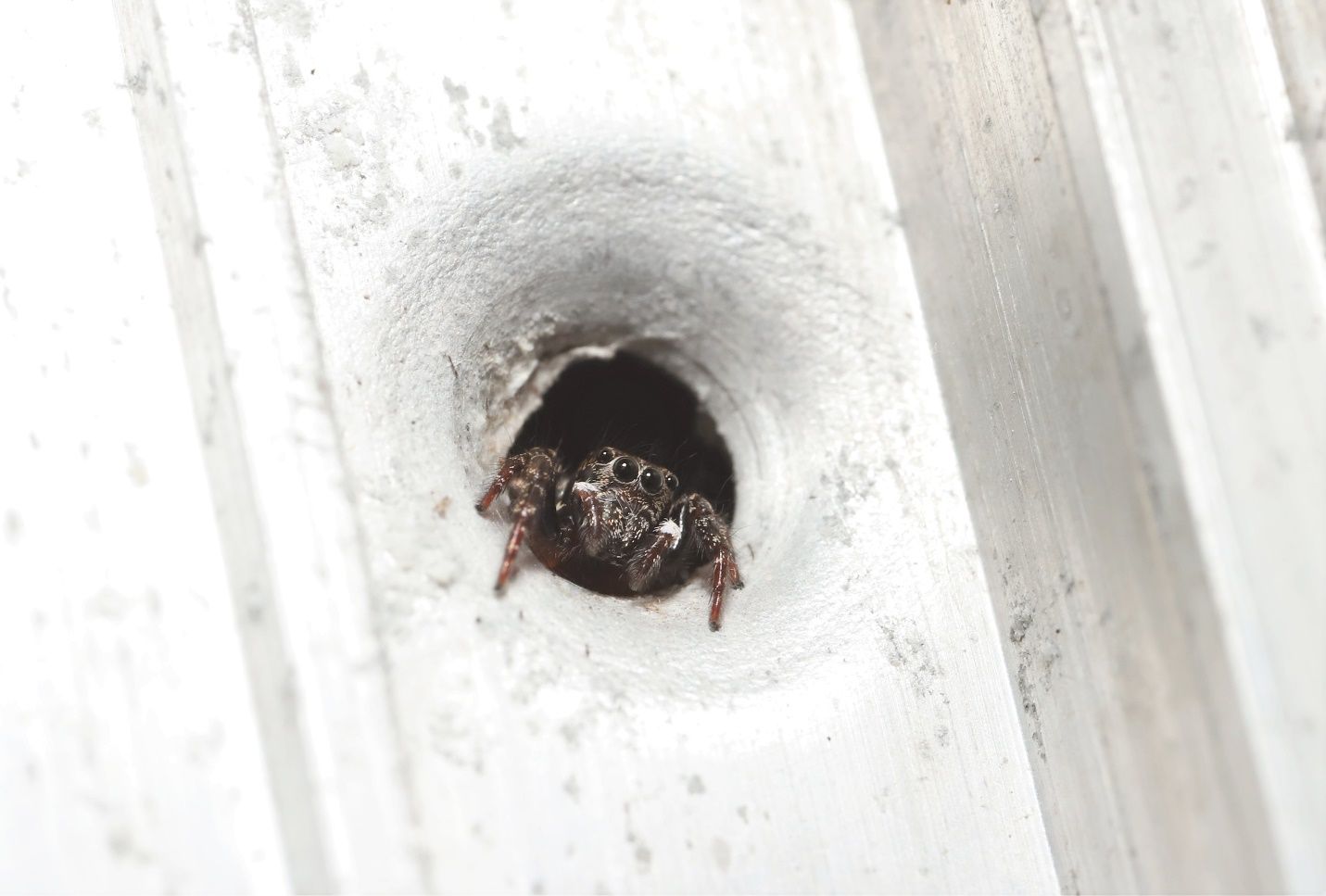
Credit: E. C. Powell, UF/IFAS
Normal locomotion of Anasaitis canosa features a hasty stop-and-go motion and often incorporates simultaneous waving of the pedipalps during pauses in motion or between steps (Jackson & Macnab 1989). This species is also able to jump upwards of fifteen body lengths from substrate to substrate or to escape from predators (Jackson & Macnab 1989).
Like most jumping spiders, Anasaitis canosa males perform complex courtship displays for females (described in detail by Jackson & Macnab 1989). The nature of this display is highly flexible and depends on where the male encounters a female and whether or not she is mature (Jackson & Macnab 1989). If he encounters a mature female away from her nest, he performs a largely visual display that includes leg waving, posturing, and tapping. However, if a male encounters a mature female when she is in her nest, his display primarily consists of tapping and vibrating his body on the outside of nest until she lets him inside. If a male encounters a juvenile female that is close to maturity in her nest, he will build a second nest chamber connected to hers and cohabitate until she matures (Jackson & Macnab 1989).
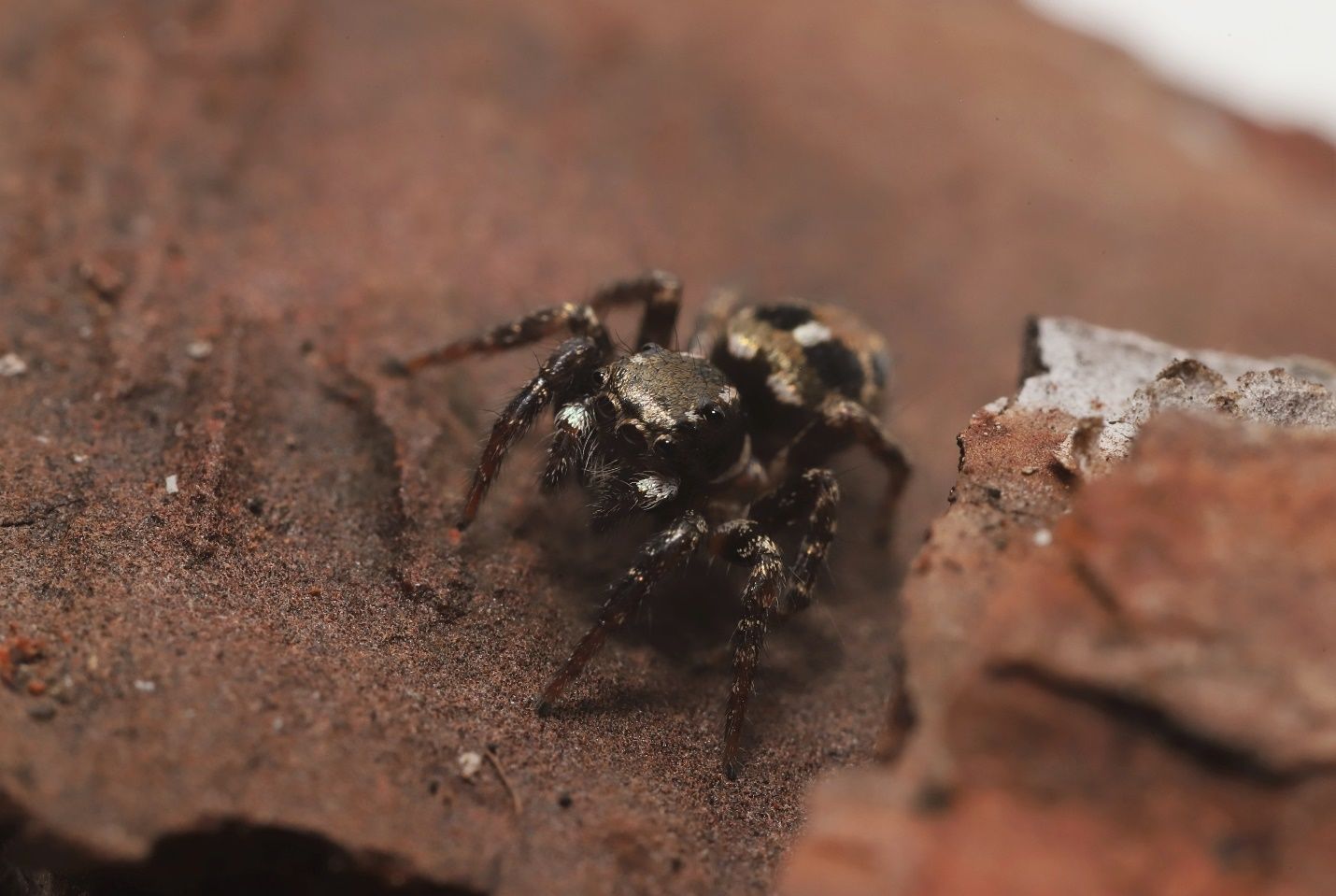
Credit: E. C. Powell, UF/IFAS
Predatory Specialization on Ants
Most jumping spiders are visual predators that hunt without the use of webs (Jackson & Pollard 1996). They have eyes specialized for high acuity, impressive cognitive abilities, and cat-like hunting tactics such as stalking and pouncing (Harland et al. 2012).
Anasaitis canosa is a specialist predator of ants, meaning that it has a unique preference for ants as prey and specialized techniques to capture them (Figure 7) (Edwards et al. 1974, Jackson & Van Olphen 1991, Hill et al. 2006). They will readily feed on a variety of different invertebrates in both the field and lab (Edwards et al. 1974; Schadegg & King 2021), but they show an active preference for ants over other insects when given the choice (Jackson & Van Olphen 1991). In a field study, Anasaitis canosa had a higher capture rate when attacking ants than when attacking other invertebrate prey (Schadegg & King 2021). This species has been documented to eat over 21 species of ants (Edwards et al. 1974). Small ant species, such as Pheidole spp. prove easier for the spiders to subdue than larger ants with harder exoskeletons (Edwards et al. 1974; Schadegg & King 2021). Preying on ants is an unusual behavior for jumping spiders; most jumping spiders that have been studied avoid ants as prey, likely due to the ants’ ability to sting and bite when attacked (e.g., Durkee et al. 2011, Edwards et al. 1974, Huang et al. 2011, Nelson 2012).
Interestingly, Anasaitis canosa has a special ant-hunting strategy, often employing large logs or branches that emerge from leaf litter as vantage points or pathways to their prey (Hill et al. 2006). They move and align their bodies with the sighted position of the ant, and then rapidly jump onto their ant prey, latching onto the ant by the back of its head or thorax, disabling the ant from stinging or biting in defense (Edwards et al. 1974, Jackson &Van Olphen 1991). This ant-specific predatory behavior is innate, meaning that is not learned and does not depend on any prior experience with ants (Jackson & Van Olphen 1991).
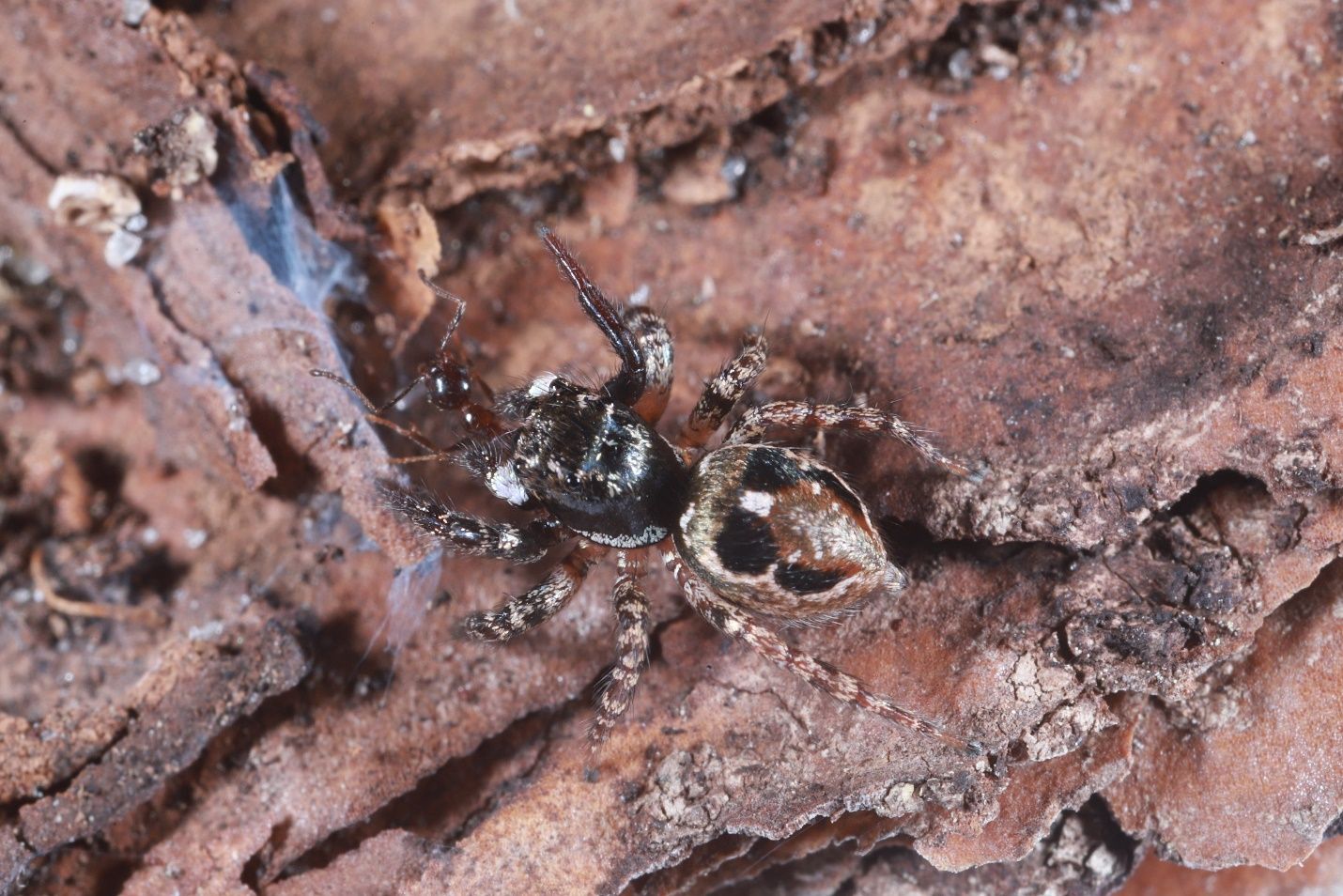
Credit: E. C. Powell, UF/IFAS
Selected References
Durkee CA, Weiss MR, Uma DB. 2011. Ant mimicry lessens predation on a North American jumping spider by larger salticid spiders. Environmental Entomology, 40(5): 1223-1231. https://doi.org/10.1603/EN11057
Edwards GB, Carroll JF, Whitcomb WH. 1974. Stoidis aurata (Araneae: Salticidae), a spider predator of ants. Florida Entomologist 57: 337-346. https://doi.org/10.2307/3493491
Edwards GB, Marshall S. 2013. Florida’s Fabulous Spiders. World Publications. Hawaiian Gardens, CA. 64 pp.
Edwards GB. 1999. Corythalia canosa (Araneae: Salticidae) reassigned to Anasaitis. Insecta Mundi 13. 10.
Foelix RF. 2011. Biology of Spiders. Oxford University Press. New York. 419 pp.
Harland D, Li D, Jackson R. 2012. How animals see the world: Comparative behavior, biology, and evolution of vision. Oxford University Press, New York p. 133-164.
Hill, DE. 2006. Predatory pursuit of ants by Anasaitis canosa (Araneae, Salticidae). Peckhamia 2: 1-6.
Huang JN, Cheng RC, Li D, Tso IM. 2011. Salticid predation as one potential driving force of ant mimicry in jumping spiders. Proceedings of the Royal Society B: Biological Sciences, 278(1710): 1356-1364. https://doi.org/10.1098/rspb.2010.1896
iNaturalist. 2022. Twin-flagged jumping spider (Anasaitis canosa). (10 February 2022) https://www.inaturalist.org/taxa/311233-Anasaitis-canosa
Jackson RR, Macnab AM. 1989. Display behaviour of Corythalia canosa, an ant-eating jumping spider (Araneae: Salticidae) from Florida. New Zealand Journal of Zoology 16: 169–183. https://doi.org/10.1080/03014223.1989.10422566
Jackson RR, Pollard SD. 1996. Predatory behavior of jumping spiders. Annual Review of Entomology 41: 287–308. https://doi.org/10.1146/annurev.en.41.010196.001443
Jackson RR, Van Olphen A. 1991. Prey‐capture techniques and prey preferences of Corythalia canosa and Pystira orbiculata, ant‐eating jumping spiders (Araneae, Salticidae). Journal of Zoology, 223(4): 577-591. https://doi.org/10.1111/j.1469-7998.1991.tb04389.x
Milne MA, Louderman J, Foster B, an Grijalva I, Lewis JJ, Bishop L, Deno BL, Acosta J, Frandsen L, Stern, E. 2019. More spiders in Indiana: 100 new and updated distribution records. Proceedings of the Indiana Academy of Science 128. 87-105.
Nelson, XJ. 2012. A predator's perspective of the accuracy of ant mimicry in spiders. Psyche 2012: 168549. https://doi.org/10.1155/2012/168549
Richman DB, Cutler B, Hill DE. 2012. Salticidae of North America, including Mexico. Peckhamia 95: 1-88.
Schadegg P, King JR. 2021. Feeding habits of the jumping spider Anasaitis canosa (Araneae: Salticidae) in the field. Florida Entomologist 104: 54-55. https://doi.org/10.1653/024.104.0109
Walckenaer CA 1837. Histoire naturelle des insectes. Aptères. Tome premier. Roret, Paris, 682 pp., pl. 1-15. https://doi.org/10.5962/bhl.title.61095
World Spider Catalog 2022. World Spider Catalog. Natural History Museum Bern, version 23.0. (7 February 2022). http://wsc.nmbe.ch
Young OP, Edwards GB. 1990. Spiders in United States field crops and their potential effect on crop pests. Journal of Arachnology 18: 1-27.